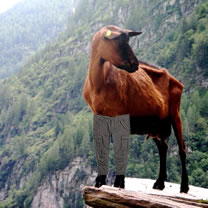
The Swedish lessons I’ve been working through recently include clothing vocabulary, such as byxor (trousers), halsduk (scarf) handskar (gloves), vantar (mittens) and stövlar (boots).
I thought I’d look into the origins of these words to help me remember them.
Byxor (trousers (UK) pants (US)) is the plural of byxa, which comes from the Middle Low German buxe, from buck (buck, male goat) & hose (trousers), originally referring to goatskin trousers. It is related to the Icelandic buxur (trousers) [source].
Halsduk (scarf, muffler, shawl) comes from hals (neck) and duk (tablecloth) [source].
Handskar (gloves) is the plural of handske, which comes from the Old Norse hanzki (glove), from Middle Low German hantsche, a colloquial form of hantscho (glove, gauntlet) from Old Saxon handsko (gauntlet, glove), from hand (hand) and sko (shoe) [source].
Related expressions include:
– handskmakare = glove maker
– handskas med = to treat, deal with, handle
Vantar (mittens) is the plural of vante (mitten, glove), which comes from the Old Swedish wante, from Old Norse vǫttr (glove, mitten), from Proto-Germanic *wantuz (glove, mitten), from Proto-Indo-European *wondʰnú- (glove), from Proto-Indo-European *wendʰ- (to wind, wrap). [source].
The PIE *wendʰ- is also the root of the English words to wander, to wend, went and wand.
Stövlar (boots) is the plural of stövel, which comes from the Old Swedish støvel (boot), from the Old Norse styfill, from Middle Low German stevele / stovele, from Italian stivale (boot), from Medieval Latin aestivale (summerly), from the Latin aestās (summer) [source].
Another word for boot is känga, which can also refer to a heavy shoe or kick, and comes from the Finnish kenkä (boot, shoe), from Proto-Finnic *kenkä (shoe) [source].
You can see more Swedish words for clothes on IE Languages.
Photo from Flickr (with added trousers).